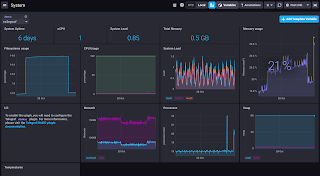Introduction
Every IoT vendor wants to be your gateway; your source of the truth; your provider of home services. In this way, they can start to monetise your usage and lock you into their vision, whilst making it more difficult for you to successfully interoperate with facilities from other vendors. But there's so much open source available, and so many competing products, that when companies start the lock-in process, the consumer can resist and use alternative facilities. Recent backlashes against Google for the retiring of the "Works with Nest" programme, the Philips strategy to kill their v1 Hue gateway, the current problems with Wink, etc. Further back, does anyone remember Revolv? And what was the name of that rabbit thing that used to waggle its ears whilst telling you about today's news? Anyone involved in consumer-based IoT is still in the wilds of multiple standards. Industry v4.0 appears to be more stable, from the questions I get from companies, but APIs are still not seen as valuable by too many IoT vendors.
This is my personal journey through IoT and home automation. It encompasses home servers, server virtualization, sensors, software utilities, and everything else I've found useful on the journey. Most, if not all, of it is targeted at consumers, so there are random disconnects, lack of enterprise facilities, holes in security, and other limitations that don't exist in the corporate world.
Full disclosure - I work for a company called InfluxData, who produce a Time Series Database platform, along with data collection, data visualization, data downsampling, data expiry and alerting. I joined InfluxData after working on "Service Virtualization", the practice of stubbing and mocking APIs to enable continued development of software while endpoints don't exist. When the company I worked for was acquired, I looked around to see where my next challenges could be met, and I was already visualizing some of the devices in my home using InfluxDB, so I applied to the company and was successful.
This is a personal blog, all views expressed being my own personal preference and nothing to do with InfluxData, but most of the posts I make will conclude with a useful graphical visualization of my configurations in the InfluxData open source tool "Chronograf" - primrily because it's my visualizaiton of choice, but also to show value in the configurations I've selected.
I use hardware and software from multiple sources, investigated both personally and by trawling through many personal blogs and YouTube videos. As such, I'll write about middleware, servers, software utilities, Zigbee gateways, etc. I will also include, where I can, complete (so far as security will permit) configurations for each part.
I am tied and faithful to very few of the components I'll be writing about. They are all tools that I've used and integrated to make my life and my concept of home automation easier for me. If you have other preferences, or I don't explain my thoughts behind the design decisions I've made, feel free to challenge me. I might change my mind, or I might defend my decision, depending on how good a case you make.
This is my personal journey through IoT and home automation. It encompasses home servers, server virtualization, sensors, software utilities, and everything else I've found useful on the journey. Most, if not all, of it is targeted at consumers, so there are random disconnects, lack of enterprise facilities, holes in security, and other limitations that don't exist in the corporate world.
Full disclosure - I work for a company called InfluxData, who produce a Time Series Database platform, along with data collection, data visualization, data downsampling, data expiry and alerting. I joined InfluxData after working on "Service Virtualization", the practice of stubbing and mocking APIs to enable continued development of software while endpoints don't exist. When the company I worked for was acquired, I looked around to see where my next challenges could be met, and I was already visualizing some of the devices in my home using InfluxDB, so I applied to the company and was successful.
This is a personal blog, all views expressed being my own personal preference and nothing to do with InfluxData, but most of the posts I make will conclude with a useful graphical visualization of my configurations in the InfluxData open source tool "Chronograf" - primrily because it's my visualizaiton of choice, but also to show value in the configurations I've selected.
I use hardware and software from multiple sources, investigated both personally and by trawling through many personal blogs and YouTube videos. As such, I'll write about middleware, servers, software utilities, Zigbee gateways, etc. I will also include, where I can, complete (so far as security will permit) configurations for each part.
I am tied and faithful to very few of the components I'll be writing about. They are all tools that I've used and integrated to make my life and my concept of home automation easier for me. If you have other preferences, or I don't explain my thoughts behind the design decisions I've made, feel free to challenge me. I might change my mind, or I might defend my decision, depending on how good a case you make.

Comments
Post a Comment